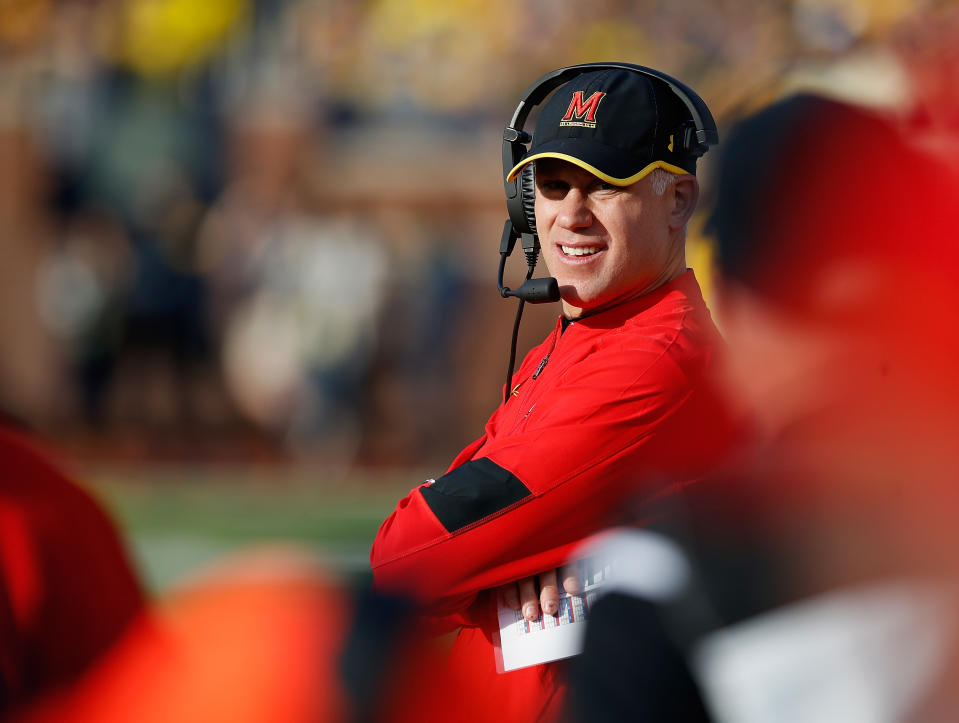At Maryland, it's time for the kids to be the adults in the room
Looks like it’s up the kids to be the adults in the room.
Maryland’s decision to retain football coach D.J. Durkin after the death of offensive lineman Jordan McNair drew outrage from everyone from columnists to congressmen. The Washington Post told readers not to send their sons to play for Durkin. Rep. Anthony Brown said the Maryland Board of Regents “did not treat Jordan as a person.”
But the real power to create change may lie with students themselves.
And they have more power than you might think.
Maryland students are planning a rally on campus on Thursday afternoon to protest the decision to keep Durkin, and already more than 1,000 have expressed interest – including the College Democrats and the College Republicans. The demonstration is scheduled for 3:30 ET, but it could be moved to allow for players to join after practice.
“A lot of students have been saying, ‘How can I be forced into supporting an athletic department that is not in line with my value system?’ ” says Jonathan Allen, who is president of the Maryland student government. He is calling on school president Wallace Loh to fire Durkin, and he’s also pushing for one more measure that could seriously kneecap the athletic department.
It involves student fees.

A significant amount of the athletic department budget at Maryland (and many other major universities) comes from mandatory fees that are weaved in with the cost of attending the school. Each Maryland student pays more than $400 per year to the athletic department, getting free admission to games in return. That adds up to millions of dollars – millions the athletic department needs. Allen and his brethren want to fight those fees.
“It’s something we’ve discussed for a while,” he says.
Media cycles move on and rallies end, but a dent in the budget would leave a mark. That’s where students both at Maryland and nationwide can gain some leverage. One recent study puts athletic fees per credit hour at nearly $8 at Florida State and more than $14 at University of Central Florida. At universities with tens of thousands of students, you can do the math.
“At most of these institutions that have entered the college sports arms race, college presidents are financing these [athletic departments] on the backs of students,” says Gerald Gurney, assistant professor of higher education at the University of Oklahoma.
Most students are blissfully unaware of these fees until the student debt piles up, or maybe not at all. But at Maryland, the students are very aware now.
“We have seen from the [Durkin] decision that the athletic department values the bottom lines more than the interests of students athletes and student body,” Allen says.
Beyond that, there’s something else students can do – specifically student-athletes.
If players decide en masse to sit down or sit out, the university is stuck. The enormous amount of television money funneling in each year is dependent on something to televise. If the players won’t play, the whole system starts to crumble.
Every Saturday my teammates and I have to kneel before the memorial of our fallen teammate. Yet a group of people do not have the courage to hold anyone accountable for his death. If only they could have the courage that Jordan had. It’s never the wrong time to do what’s right. pic.twitter.com/AaZVmLGTtS
— Ellis McKennie (@emck_cubed97) October 30, 2018
It’s happened before. Five years ago, Grambling players decided not to board a team bus for a road game as a way of protesting poor athletic facility conditions. The team had to forfeit. The facilities were soon upgraded. That episode caused a raft of national headlines, so imagine what a Big Ten boycott could do.
Obviously, there would be major risk to the players. Their scholarships are determined by the head coach. So the players’ immediate futures would be at the whim of the very leader that’s under such scrutiny – Durkin.
That’s what made the U.S. women’s national hockey team protest so stunning: the players risked the World Championships and the Olympics for better pay. They knew when they took their stand in 2017 that they may never play another minute of hockey for their country. And they knew the ramifications for their futures may extend for years. It worked: they won the standoff and they won gold.
College football players arguably have even more at stake, because they are trying to earn a degree. Plus, there are individuals hoping to make it to the professional level and seniors who surely want to play in a bowl game as a group before advancing into the real world. Would NFL scouts or future employers frown upon this kind of revolt? Keep in mind that a lot of players get their first jobs through connections within the football program.
“The one thing that is very clear is there are certain power dynamics in athletic departments,” says Allen. “Student-athletes do not speak up because they have college scholarships on the line. Futures on the line. Careers on the line.”
But there will be no NFL for Jordan McNair. There will be no first job for him. There will be no college degree. That’s the searing truth behind all of this, and the motivation for action.
“This is to get justice for Jordan,” Allen says.
The university didn’t do enough to get justice for Jordan. But the students, depending on how far they’re willing to go, wield a power they themselves may not fully comprehend.
More from Yahoo Sports:
• Ugly foul on former MVP draws police to NBA court
• Coach calls illegal timeout and retires on the spot
• Winners and losers at the NFL trade deadline
• Terez Paylor: Why KC stood pat at trade deadline

